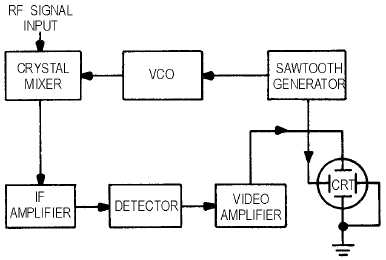5-23
SPECTRUM ANALYZER OPERATION
The information desired from the spectra to be analyzed determines the SPECTRUM ANALYZER
requirements. Real-time analysis is used if a particular point in the frequency spectrum is to be analyzed,
such as a line spectra display. Continuous- or swept-frequency analysis, which is the most common mode
of observation, is used to display a wider portion of the frequency spectrum or (in some cases) the entire
range of the spectrum analyzer in use. Changing the spectrum analyzer setting from one mode to another
is accomplished by varying the scan time and the bandwidth of the spectrum analyzer or a combination of
the two. Most real-time spectrum analyzers, however, are preceded by mechanical filters, which limit the
input bandwidth of the spectrum analyzer to the desired spectra to be analyzed. Tunable- or swept-
spectrum analyzers function basically the same as heterodyne receivers, the difference being that the local
oscillator is not used but is replaced by a voltage-controlled oscillator (vco). The vco is swept
electronically by a ramp input from a sawtooth generator. The output of the receiver is applied to a crt,
which has its horizontal sweep in synchronization with the vco. The lower frequency appears at the left of
the crt display. As the trace sweeps to the right, the oscillator increases in frequency. Figure 5-24 is a
block diagram of a heterodyne spectrum analyzer.
Figure 5-24.—Block diagram of a heterodyne spectrum analyzer.
Before the frequency of a signal can be measured on a spectrum analyzer, it must be RESOLVED.
Resolving a signal means distinguishing it from other signals near it. Resolution is limited by the
narrowest bandwidth of the spectrum analyzer because the analyzer traces out its own IF bandwidth shape
as it sweeps through a signal. If the narrowest bandwidth is 1 kilohertz, the nearest any two signals can
be, and still be resolved, is 1 kilohertz. Reducing the IF bandwidth indefinitely would obtain infinite
resolution except that the usable IF bandwidth is limited by the stability of the spectrum analyzer. The
smaller the IF bandwidth, the greater the capability of the analyzer to resolve closely spaced signals of
unequal amplitudes. Modern spectrum analyzers have been refined to the degree that IF bandwidths are
less than 1 hertz.
It is important that the spectrum analyzer be more stable in frequency than the signals being
measured. The stability of the analyzer depends on the frequency stability of its vco. Scan time of the
spectrum analyzer must be long enough, with respect to the amplitude of the signal to be measured, to
allow the IF circuitry of the spectrum analyzer to charge and recover. This will prevent amplitude and
frequency distortion.

